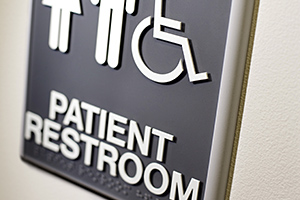Nick Haslam, a professor of psychology at the University of Melbourne, recently wrote that it's time for psychologists to stop ignoring excrement. A U.K. survey in 2010 ranked the flushing toilet as the 9th greatest invention of all time (sliced bread ranked 70th).
Anish Sheth, MD, a Yale gastroenterologist and the author of What's Your Poo Telling You? says, "What comes out tells you a lot about what's going on inside." Dr. Craig Maxwell, who is board certified in family medicine, integrative medicine and osteopathic medicine, says people who quickly flush, clean up and leave the room are missing some vital clues about the state of their health.1 For many patients, this may seem disgusting or embarrassing, but taking a moment to look before flushing can be quite informative.
Texture / Consistency
The texture and consistency of poop may be a sign of what's going on inside:2-3
- Fluffy pieces with ragged edges, mushy – this is on the edge of normal, but is on its way to becoming diarrhea.
- Watery, no solid pieces, all liquid – this is diarrhea, which is probably caused by some sort of infection, since this is the body's way of cleaning itself. Make sure to drink lots of clear liquids to replace the fluids lost; otherwise, dehydration could occur.
- Soft and sticks to the side of the toilet bowl – this indicates the presence of too much oil, which is possibly the result of improper absorption of fats and could be a sign of disease, such as chronic pancreatitis.
- Soft blocks with clear-cut edges – not too bad, pretty normal for someone who is pooping multiple times a day.
- Separate, hard lumps like nuts – this is a sign of a lack of fiber and fluids; drink more water and eat more vegetables.
- Sausage-shaped, but lumpy – not as serious as separate, hard lumps: still need to drink more water and eat more vegetables.
- Sausage-shaped, but with cracks on the surface – this is normal, but the cracks signify the need for more water.
- Sausage-shaped, smooth and soft – optimal poop.
 The only shape or consistency that could be a concern is pencil-thin stools for more than a week. Skinny bowel movements can indicate a serious problem, especially if they become thinner over several weeks. If this occurs, encouraging your patient to request a colonoscopy may be wise.
The only shape or consistency that could be a concern is pencil-thin stools for more than a week. Skinny bowel movements can indicate a serious problem, especially if they become thinner over several weeks. If this occurs, encouraging your patient to request a colonoscopy may be wise.
Something else to consider: a stool that is floating. This is typically harmless, but may be a sign of either too much gas, a gastrointestinal infection or malabsorption. Floating stool is not a reason to contact a primary care provider unless it is accompanied by sudden weight loss, dizziness or fever.4
Color
In most cases, excrement should be brown. While diet may sometimes result in a change of color (for instance, blueberries may turn bowels blue and beets will frequently cause a red tint), poop is supposed to be brown. Colors other than brown may indicate a health issue:3
- White or clay-colored stools may indicate a lack of bile in the stool – this may be caused by insufficient bile output or obstruction due to conditions such as gallstones, parasitic infection, hepatitis, chronic pancreatitis, etc. However, medications such as antacids, Pepto-Bismol or Kaopectate also may cause this color. Remember that stomach acids are an important part of digestion, and antacids taken too frequently may actually cause heartburn, as well as digestion and elimination issues.
- Green stool is typically caused by overactive or increased bowel transit time, meaning the bile doesn't have time to change from green to brown. This may be caused by food poisoning, Crohn's disease, ulcerative colitis, irritable bowel syndrome or other diseases, as well as alcoholism and the side effects of some medications including antibiotics or over-the-counter drugs.
- Yellow stool is primarily caused by an inability to digest fat – inadequate digestive enzyme production from the pancreas, celiac disease, cystic fibrosis or intestinal infections.
- Black, tarry stools are typically caused by bleeding somewhere in the digestive tract (esophagus, stomach, duodenum, small intestine, colon) – this also may be a symptom of Crohn's disease, ulcerative colitis, intestinal infection or diverticulosis, and gastritis, or it could be indicative of cancer. However, black licorice, blueberries, beets, tomatoes, lead, iron pills and medications such as Pepto-Bismol also may cause this appearance.
- Red stool is typically caused by intestinal bleeding – although the stool is not usually entirely red, the causes are similar to those of black, tarry stool, but also may be caused by food coloring and certain dietary supplements.
Baby Poop
As with adults and children, baby poop can be a sign of how the body is functioning, but it is different for breastfed as opposed to bottlefed infants.5 Breastfed babies typically have yellow poop speckled with tiny "seeds" (like fancy mustard) and will poop more than once a day – usually after they are fed. Bottlefed babies have tan, yellow or greenish poop and will typically need a diaper changed once a day.
Be aware that a breastfed baby may absorb the nutrients in their mother's milk more completely, so it's not completely uncommon for a breastfed baby to go a few days without a bowel movement. However, if they're straining or uncomfortable, this could be a sign of constipation. Babies that have bloody stools or mucus in their stools should be taken to their primary care provider.5
Stress Concerns
Studies in the fields of psychosomatic medicine and gastroenterology suggest many bowel complaints have a large psychological component. One example is irritable bowel syndrome (IBS). This common condition is characterized by chronic or alternating diarrhea and constipation, sometimes accompanied by bloating, discomfort and abdominal pain. Studies have shown it's difficult to confirm a cause, but those with IBS tend to score high when tested for neuroticism, and find many of their health issues have a basis in anxiety and depression. Sufferers of IBS may have problems with self-assertion and often report histories of abuse.6-7
Studies in neurogastroenterology are beginning to uncover some of the roots of IBS, suggesting it may be tied to the enteric nervous system – the "second brain" that controls the internal organs, especially the intestines.6,8
The Impact of Medication
Constipation and other bowel issues have been linked to some prescription and OTC medications. For instance, opioid-based pain relievers may cause constipation. Antibiotics may destroy the good bacteria in the bowels while going after the bad bacteria, so consider taking probiotics after any course of antibiotics.9
A bigger concern, however, may be over-the-counter laxatives used for constipation. Oral laxatives may interfere with absorption of nutrients, but that's not as worrisome as what happens when they're taken in excess. Eventually, the body becomes dependent upon them and they must be taken even more frequently; however, with greater use, the body can become immune to the drug.
Before a patient begins taking any laxative, encourage them to try lifestyle changes first: eating more fiber-rich foods, drinking more water and exercising regularly. Even going for a 20-minute walk once a day for a week can help regulate bowel movements.10
The Chiropractic Factor
Since the central nervous system controls all of the systems including digestion and elimination, bowel issues may be related to vertebral subluxation. Many parents of children and newborns have reported that after a few gentle adjustments, their little ones were able to have normal, healthy bowel movements. And it's not unusual in my practice to have a constipated baby fill their diaper immediately following an adjustment.
References
- Maxwell DA. "Why You Should Look at Your Poop Before You Flush." AskDrMaxwell.com, Aug. 25, 2014.
- Mercola J. "What You See in the Toilet Can Give You Valuable Insights Into Your Health." Mercola.com, Feb. 14, 2013.
- "Before You Flush: Look Inside the Bowel to Learn About Your Health." Women's Health magazine.
- Health Guide - Stools, Floating. New York Times online health section.
- "The Scoop on Baby Poop." WebMD.com Health & Parenting Center, Health & Baby Center.
- Haslam N. "Toilet Psychology." British Psychological Society, June 2012.
- Talley NJ, Boyce PM, Jones M. Is the association between irritable bowel syndrome and abuse explained by neuroticism? A population based study. Gut, 1998;42:47–53.
- Elsenbruch S, Rosenberger C, Enck P, et al. Affective disturbances modulate the neuralprocessing of visceral pain stimuli in irritable bowel syndrome: an fMRI study. Gut, 2010;59:489-494.
- "8 Common Digestive Problems and How to End Them." U.S. News & World Report, Sept. 6, 2012.
- "Over-the-Counter Laxatives for Constipation: Use With Caution." Mayo Clinic, June 6, 2014.
Click here for previous articles by Claudia Anrig, DC.





